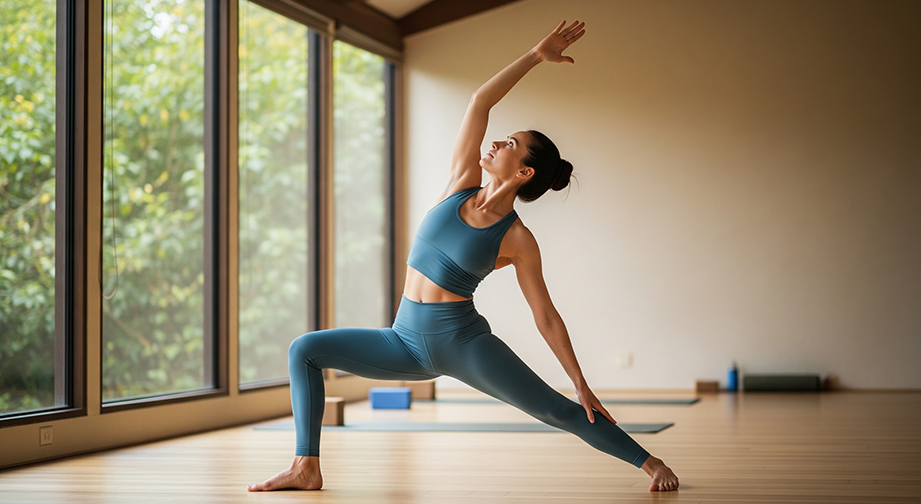Viparita Virabhadrasana (Reversed Warrior Pose): A Complete Guide
Introduction
Viparita Virabhadrasana (pronounced vi-par-ee-ta veer-a-bad-rahs-ana), is known in English as the Reversed Warrior Pose. This graceful, empowering standing yoga asana involves a deep side stretch while anchoring firmly through the legs.
The Sanskrit name "Viparita" means "reversed" or "inverted," and "Virabhadrasana" stands for the fierce warrior, evoking courage and strength. The essence of this pose? Both energizing and grounding, while opening both heart and side body.
Feeling stiff after long hours at your desk? Viparita Virabhadrasana might just be your go-to remedy to melt away tension and tap into your inner resilience.
Step-by-Step Guide to Reversed Warrior

- Start in Warrior II (Virabhadrasana II): Stand with feet wide apart. Turn your right foot out 90 degrees, left foot in slightly. Bend your right knee, keeping it over your ankle. Stretch arms parallel to the floor, gazing over your right fingertips.
- As you inhale: Flip your right palm to face up. Reach your right arm up and overhead, sweeping it toward the sky, keeping the bicep close to the ear.
- As you exhale: Slide your left hand gently down the back of your left leg. Lean your torso slightly back, opening your heart to the ceiling, but keep your front knee deeply bent.
- Hold the position: Stay here for 3–8 breaths, feeling the side stretch and breathing deeply. Gaze can be up toward your lifted arm or down at your back foot for neck comfort.
- Release: Inhale to return to Warrior II. Repeat on the left side.
- Breathing tip: Inhale while reaching up and opening the chest, exhale to deepen into the stretch.
- Duration: 1–2 rounds per side, holding for 15–30 seconds each round.
Modifications & Intensifications
- For beginners: Rest your back hand lightly on your hip or thigh instead of reaching down. Keep a slight bend in the front knee if needed, and don’t go as deep.
- For advanced: Reach further with the top arm, engage the thighs for a deeper lunge, and intensify the side stretch.
Alignment & Safety Tips
- Key Alignment Cues:
- Knee stacks above the ankle, not moving inward.
- Feet pressed firmly into the mat for stability.
- Side body (not the low back) does the main bending and stretching.
- Shoulders away from the ears.
- Back leg remains strong and straight.
- Common Mistakes:
- Leaning too far back or collapsing into the lower back.
- Letting the front knee collapse inward.
- Twisting the chest rather than opening up sideways.
- Safety Precautions:
- Avoid this pose if you have serious knee, hip, or shoulder injuries.
- If pregnant or with balance issues, use a wall or chair for support.
Benefits of Viparita Virabhadrasana
Physical Benefits:
- Strengthens legs, ankles, hips, and shoulders
- Increases flexibility in the side body, groin, and spine
- Improves balance, endurance, and posture
Mental Benefits:
- Relieves stress and fatigue
- Enhances focus and concentration
- Promotes a sense of calm, confidence, and empowerment
Energetic/Chakra Connection:
- Opens the heart center (Anahata Chakra)
- Stimulates grounding energy (Root Chakra)
Contraindications
- Those with recent or chronic knee, hip, shoulder injuries, or severe balance issues should avoid this pose.
- If you have high blood pressure or vertigo, practice with caution and under supervision.
Alternatives: Try Side Angle Pose (Utthita Parsvakonasana) or perform the pose with a chair for additional support.
Beginner’s Tips & Variations
- Props: Place a block under the back hand for support, or use a wall to stabilize your stance.
- Gentle Variations: Shorten your stance, take a gentler bend in the knee, or rest back hand on hip.
- Advanced Variations: Deepen the lunge, bring the back hand all the way down to the calf or ankle, or hold the top arm back behind the ear for a stronger side stretch.
How to Include Viparita Virabhadrasana in a Yoga Flow
- Works well as main practice or in the warm-up phase for energetic flows.
- Pairs beautifully with:
- Warrior II (Virabhadrasana II)
- Extended Side Angle Pose (Utthita Parsvakonasana)
- Triangle Pose (Trikonasana)
- Follow with a gentle counterpose, such as Downward Dog or Child’s Pose.
Mind-Body Connection
As you practice Viparita Virabhadrasana, invite mindfulness to every movement. Notice the energetic expansion throughout your heart and chest, grounding through your legs. Allow the pose to evoke strength and serenity—a true embodiment of the warrior’s spirit.
Chakra significance: This asana helps unlock the heart (Anahata) chakra, inviting openness, compassion, and courage.
Summary Box: Viparita Virabhadrasana (Reversed Warrior Pose)
- Asana Name: Viparita Virabhadrasana (Reversed Warrior Pose)
- Level: Beginner to Intermediate
- Focus Areas: Legs, hips, side body, chest, shoulders
- Duration: 15–30 seconds per side; 1–2 rounds
- Best Time to Practice: Morning or evening
Frequently Asked Questions
Is Reversed Warrior Pose good for beginners?
Yes! With simple modifications and use of props, Viparita Virabhadrasana is accessible for most beginners.
What can I do if my balance feels shaky?
Practice near a wall or take a shorter stance to build confidence and stability.
What should I feel in this pose?
A stretch through the side body, strengthened legs, and a sense of opening across your chest and shoulders.
Always consult your physician before beginning a new exercise program, especially if you have health concerns.